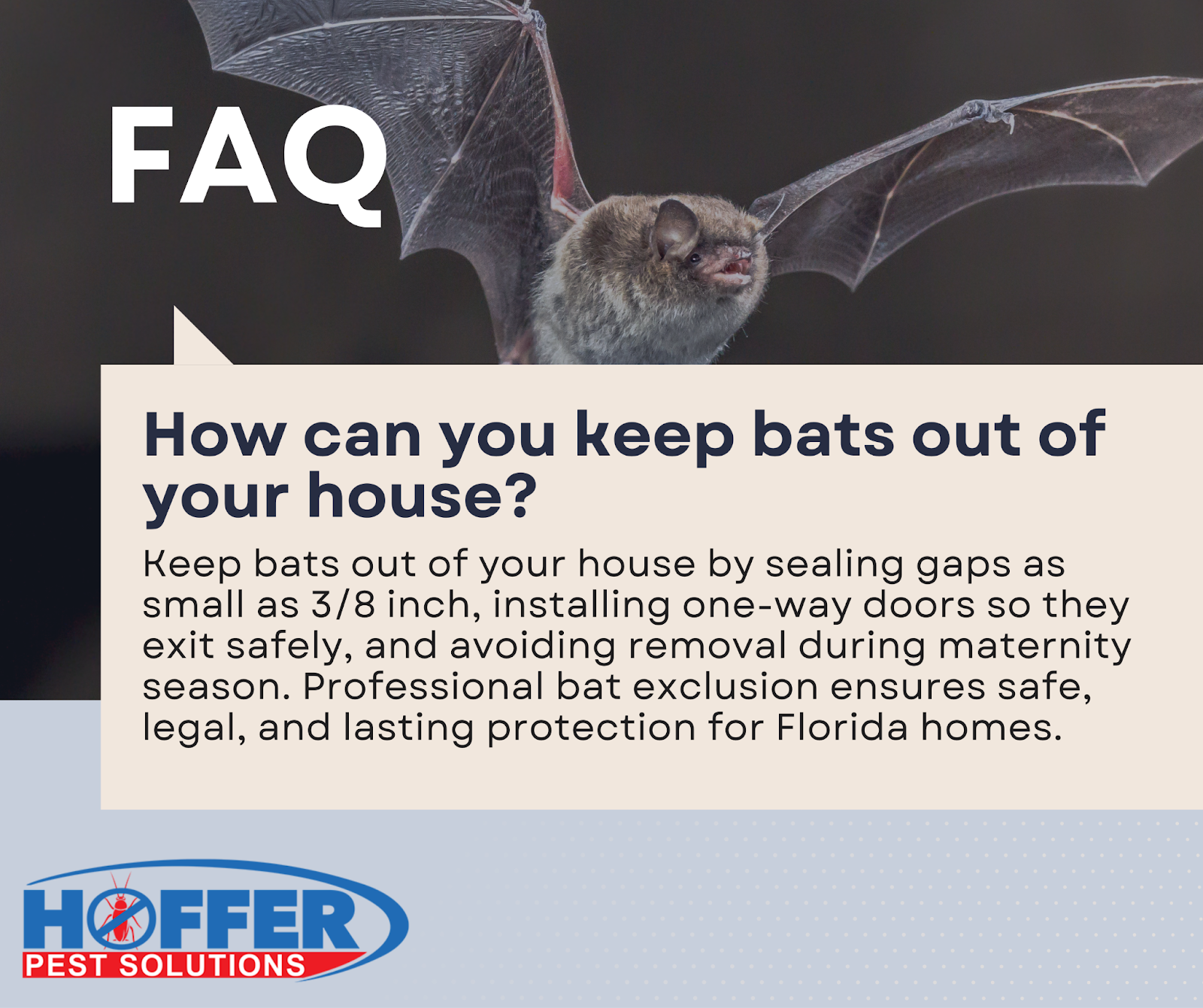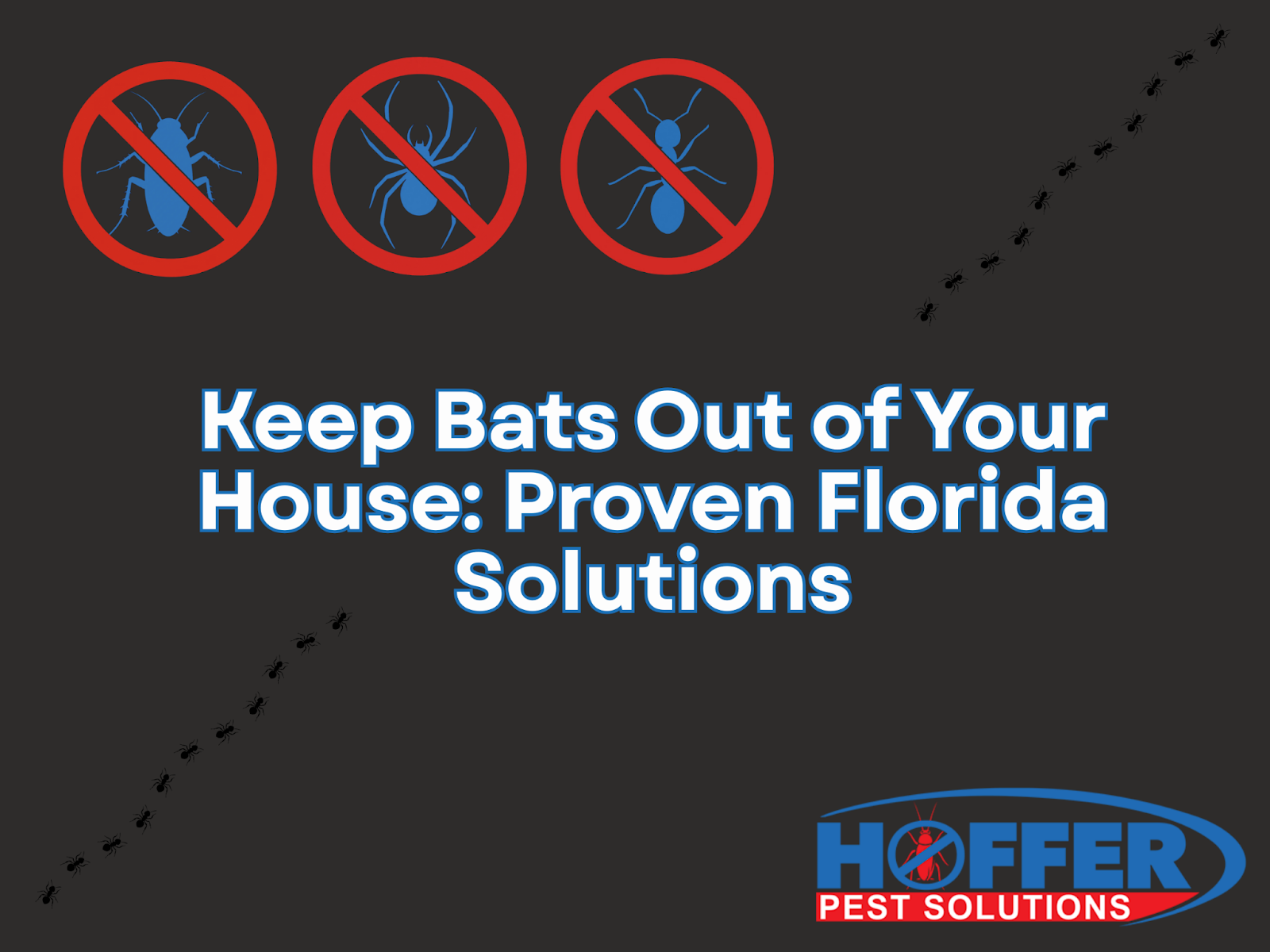Keep bats out of your house by sealing gaps as small as 3/8 inch, installing one-way doors so they exit safely, and avoiding removal during maternity season. Professional bat exclusion ensures safe, legal, and lasting protection for Florida homes.

Florida’s warm climate makes homes a magnet for bats searching for shelter and easy access to insects. While bats are helpful outdoors, they bring serious risks indoors, from guano damage and foul odors to the threat of rabies exposure.
The good news? With the right steps, you can protect your family and your property. In this guide, we’ll cover how to inspect your home, use safe exclusion methods, secure every gap, and keep bats from coming back.
If you’d rather not climb ladders, handle guano, or worry about Florida’s bat laws, Hoffer Pest Solutions is here to help. As a family-owned company serving South Florida for over 40 years, we specialize in humane bat removal and prevention that keeps your home safe long-term.
Want the full breakdown? Below, we’ll walk you through each step of the process so you know exactly how to keep bats out of your house.
Step-by-Step Guide to Keeping Bats Out of Your House in Florida
Before diving into the details, it helps to know that the safest way to remove bats is with a clear, methodical process. Follow these steps to humanely exclude bats, secure your home, and prevent future infestations.
Step 1: Inspect & Identify Entry Points
Exclusion begins with a thorough inspection. Bats can slip through gaps as narrow as 3/8 of an inch, meaning even the tiniest crack around soffits, chimneys, or vents can be an open door. At dusk, watch where bats exit with the help of a flashlight.
Temporary deterrents can buy time. For example, smooth aluminum flashing or plastic sheets placed under soffits create “no-grip” surfaces that discourage porch roosting. But sealing must be strategic. Caulking cracks too early can trap bats inside, creating odors and legal issues. The safe path is to identify all active entry points first, then prepare one-way devices that let bats out without letting them back in.
Step 2: Safe, Legal Bat Exclusion
Exclusion, not poisons or repellents, is the only humane and legal method of removing bats from homes in Florida. One-way doors, bat cones, or netting tubes allow bats to leave at night and prevent them from re-entering. After several days of clear nights, the devices can be removed and openings permanently sealed.
Timing is everything. Exclusions must be done outside of maternity season, typically April through August, when flightless pups depend on their mothers. Attempting removal too early can trap and kill young bats, creating legal penalties and sanitation nightmares. A safe approach respects wildlife laws, ensures bats survive outdoors, and protects your home’s interior.
Step 3: Seal and Secure the Home
Once bats have safely exited, sealing the home keeps them from returning. Gaps around soffits, vents, and chimneys should be caulked or screened with fine, bat-proof mesh. Chimney caps and vent covers add extra protection while preserving airflow.
Some homeowners have found success with creative one-way slides using PVC tubing that prevents bats from landing and climbing back in. Others use draped netting over small holes, allowing bats to crawl out but not re-enter. These tools only work when properly installed and monitored for several nights. Once activity stops, sealing every gap permanently ensures your attic or porch won’t become a bat roost again.
Step 4: Clean Up and Sanitize
Excluding bats is only half the battle. Guano and urine left behind can corrode wood, ruin insulation, and spread odor throughout your home. Professional cleanup ensures spores that cause histoplasmosis are safely removed. This step restores the integrity of your attic or porch while protecting your family’s health.
Step 5: Monitor for Returning Activity
Even after sealing and cleanup, it’s smart to monitor your home for several weeks. Watch for new guano piles, listen for squeaks at dusk, and check sealed areas after storms. Catching issues early prevents another infestation from taking hold. Many homeowners add this check to their seasonal maintenance.
Step 6: Prevent Future Infestations
Long-term prevention means reducing what attracts bats in the first place. Switching exterior lights to yellow “bug bulbs,” minimizing standing water, and scheduling mosquito treatments can make your property less appealing. For some families, installing bat houses away from the home is a win-win: bats still thrive, but your living space stays secure.
Signs You Have Bats in Your House
Recognizing the early warning signs of bat activity helps you act before the problem grows. Homeowners often notice guano piles accumulating near eaves or attic access points. Others hear faint squeaks, chirps, or scratching noises around dusk and dawn. Stained soffits, ridge vents, or chimney gaps marked by smudges are also strong indicators of entry points.
Some worry that investigating these areas could provoke an attack. In reality, bats aren’t aggressive toward humans. The bigger risk comes from accidental contact or improper handling. Approach cautiously, avoid direct contact, and remember that professional inspections can remove uncertainty while keeping you safe.
Call Hoffer Pest Solutions today and claim your free inspection.
Short-Term Deterrents (With Limitations)
Some deterrents may offer short-term relief but should never replace exclusion. Bright porch lights can disrupt bats that choose soffits or rafters for rest. Homeowners often find success leaving high-lumen lights on for a week to encourage bats to move on. For better results, swap white LEDs for yellow “bug bulbs,” which reduce insect activity and make porches less appealing to bats.
Other options like peppermint oil, cinnamon sprays, or ultrasonic devices are widely marketed but often ineffective. Bats quickly adapt to noise or scent changes, and these methods can sometimes create more discomfort for people than bats. The bottom line: short-term tactics may discourage activity temporarily, but sealing and exclusion are the only lasting fixes.
Why Bats Pick Your House
Florida homes are particularly vulnerable to bat entry because of their architectural features. Open soffits, tile roofs, and warm attic voids mimic the sheltered, cave-like environments bats prefer. Nearby water features, pools, or irrigation attract insects, which in turn draw bats closer to your property. Even porches without lights can harbor insect swarms from ambient lighting or landscaping, making them convenient resting spots for bats.
It’s also necessary to remember that not every bat presence signals a colony. Sometimes a lone bat rests under an eave after a night of foraging. While that doesn’t mean you have an infestation, it should prompt you to keep watch for signs of repeated activity.
Bat Houses: Giving Them a Better Option
Bats are a key part of Florida’s ecosystem, consuming thousands of insects each night. Installing a bat house provides them with an alternative roosting site away from your attic or porch. For success, mount bat houses 12–15 feet high in a sunny location with minimal nighttime disturbance.
Homeowners often ask, “How high do bat boxes need to be?” At least 12 feet is recommended, with early morning sun exposure to keep them warm. Installing a bat house before sealing attic gaps is a smart strategy, it encourages bats to relocate nearby, preserving their ecological benefits while keeping your home safe.
Health & Safety Concerns
The risks of bat infestations go beyond inconvenience. Guano accumulations can harbor fungal spores that cause histoplasmosis, a respiratory illness that can be serious if inhaled. Even small piles of droppings can contaminate insulation and drywall, leading to long-term structural issues.
Rabies is another concern. While only a small percentage of bats carry the virus, any potential bite or scratch requires immediate medical evaluation. Homeowners often worry about the pain and process of post-exposure vaccinations, making prevention all the more critical. Always wear protective equipment when cleaning, and for large or contaminated spaces, rely on professional remediation to ensure safety.
Costs & When to Call a Professional
The cost of bat exclusion can vary widely depending on the home’s size, the number of entry points, and the extent of contamination. Basic DIY efforts like netting, caulk, or vent covers may cost only a few hundred dollars. Professional exclusion, however, often ranges from $200 to over $1,800, with higher prices for extensive repairs or guano cleanup.
Some homeowners are surprised at quotes like $1,800 “just to plug holes,” but this often reflects the complexity of sealing an entire structure and ensuring legal compliance. Professionals bring specialized equipment, training, and guarantees that bats will not return. Large colonies, heavy contamination, or hard-to-reach attics are all clear signals it’s time to call in pest control.
Local Florida Expertise: Why Work With Hoffer Pest Solutions
When it comes to protecting your home, experience matters. Hoffer Pest Solutions has been family-owned and operated in South Florida for more than 40 years, serving Broward, Miami-Dade, and Palm Beach counties. Living and working in the same communities as our customers means we understand the unique challenges of Florida homes, open soffits, tile roofs, and the ever-present humidity that bats find inviting.
We offer same-day inspections if you call before noon, giving you peace of mind fast. Our team specializes in humane bat exclusion, guano cleanup, and sealing strategies that align with Florida wildlife laws. Backed by more than 1,000 reviews and a 4.9-star rating, we take pride in providing reliable service that balances effectiveness with compassion for the animals we remove.
Our Home Shield Advantage and Home Shield Complete programs go beyond bats, offering year-round protection against rodents, termites, ants, mosquitoes, and more. With a single plan, homeowners can protect their largest investment, their home, from a wide variety of pests.
Peace of Mind for Your Home
Bats are critical to Florida’s ecosystem, but they don’t belong inside your home. Humane exclusion, sealing, and cleanup are the only lasting solutions.
We’ve protected South Florida families for more than 40 years with same-day inspections, exclusion, and long-term prevention. As a local, family-owned company, we treat your home like our own.
Call Hoffer Pest Solutions today for a same-day inspection and take the first step toward a safe, healthy, and bat-free home.
Frequently Asked Questions (FAQ)
How long does it take to fully get bats out of a house?
Most exclusions take one to two weeks. This allows enough time for bats to exit naturally at night, confirm no young are left behind, and then safely seal entry points.
Can bats chew or claw their way back into my attic?
No. Unlike rodents, bats don’t chew through wood or wires. They only exploit existing gaps and cracks, which is why sealing and screening are effective solutions.
Are there times of year when I can’t remove bats in Florida?
Yes. Florida has a maternity season, typically April through August. Exclusions aren’t permitted during this period because pups are flightless and would be trapped inside.
Will installing a bat house guarantee bats leave my attic?
Not always. Bat houses are most effective when combined with exclusion. They give bats an alternative roost, but sealing your attic remains the only guaranteed way to keep them out.
Do homeowner’s insurance policies cover bat removal?
Coverage varies. Some policies may cover damage caused by wildlife but exclude cleanup or exclusion services. Always review your policy or consult your agent before scheduling work.


